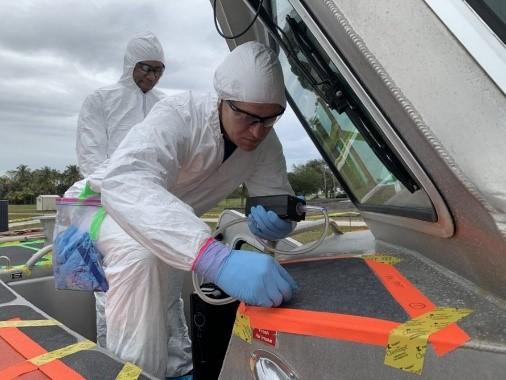EPA Researchers Expand Wide-Area Decontamination Research to Ships and Coastal Areas
Published September 1, 2020
 Researchers with the United States Coast Guard conduct sampling for biological spores. Understanding how a biological agent can spread in the environment, how long it persists, and how we can clean it up is vital to protecting people, entities, and assets in the United States.
Researchers with the United States Coast Guard conduct sampling for biological spores. Understanding how a biological agent can spread in the environment, how long it persists, and how we can clean it up is vital to protecting people, entities, and assets in the United States.
A biological agent, like Bacillus anthracis spores (which causes anthrax), can easily spread over a large outdoor area, which presents a considerable threat and challenges our environmental response to remediate the area. Bacillus anthracis spores are difficult to kill, therefore they can remain viable for many years and spread through natural forces such as wind and rain, as well as human activities.
Under the National Response Framework, EPA, U.S. Coast Guard (USCG), and the U.S. Department of Homeland Security (DHS) have responsibilities to prepare for and respond to a threat to public health, welfare, or the environment caused by a release of a hazardous substance.
The Analysis for Coastal Operational Resiliency (AnCOR) project is a collaboration between these agencies to develop capabilities and strategic guidelines to prepare the United States for a wide-area release of a biological agent. This project continues to build on the knowledge and experience generated through previous projects, such as the Bio-response Operational Testing and Evaluation project as well as the Underground Transportation Restoration project. Each of these projects offers an environment that presents unique challenges for decontamination: for example, a building, railcar or subway station, a ship or coastal areas.
As part of the AnCOR project, EPA researchers participated in a vessel decontamination demonstration in January 2020. It is necessary to conduct full scale demonstrations and exercises in multiple environments to prepare for and understand real-world consequences of potentially devastating contamination incidents.
“Every environment is different,” explained EPA scientist Lukas Oudejans. “For example, we normally say that when you are surface sampling, you should avoid touching any surface as to avoid contamination of your personal protective equipment. When you think of a vessel like a ship or a boat, though, it’s very tight quarters and you often need to put a hand on the wall or handrail to steady yourself, so we need to be able to adapt to that.”
There is currently a lack of readily available tools and field-tested methods to address such a wide-spread biological contamination event. This demonstration used a non-hazardous(?) surrogate pathogen to allow researchers to test lab-developed methods in a real-world setting. During the demonstration, members of USCG and DHS were able to practice different protocols to identify which worked best for a small vessel situation. It was an important step in preparing to mitigate impacts to USCG facilities and assets, such as ships, in the case of a wide-area release of a biological agent.
“Demonstrations like this are a great opportunity to apply research and methods in an operational scale,” explained EPA microbiologist Worth Calfee. “It’s really the end piece that allows you to make our methods applicable in the real world. Everything is very controlled in the lab, so this demonstration allowed us to account for the ‘unknowns’ and create a useable solution.”
The AnCOR project will continue to develop and demonstrate capabilities and strategic, science-based guidelines to support wide-area response and remediation decisions. EPA, USCG, and DHS are developing small-scale pilot projects that will culminate in a large-scale, wide-area demonstration in 2021.
“Really, this has been a great example of the collaboration between different agencies,” said Oudejans. “It is teamwork like this that allows our research to serve the public.”
